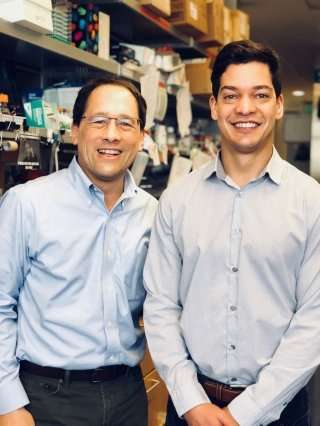Potential new treatment identified for drug-resistant skin cancer

Stanford researchers have learned how basal cell carcinoma evades drug treatment without mutating. The researchers found possible drug targets that may allow for more personalized treatment of this common skin cancer.
Over half of newly diagnosed advanced or metastatic basal cell carcinomas are resistant to currently approved drug treatments. Yet many of these skin cancers harbor no known resistance-associated genetic mutations, leaving researchers and clinicians wondering how they manage to evade treatment.
Now, researchers at the Stanford University School of Medicine have identified a link between changes in the cancer cells' internal scaffolding and one of the last steps of the cellular signaling pathway that drives their growth. This previously unknown connection allows the cells to neatly sidestep the effects of currently approved drugs without requiring them to acquire specific genetic mutations.
The researchers found that blocking this connection using an inhibitor previously used to treat inflammation significantly slowed the growth of drug-resistant basal cell carcinomas in mice. Moreover, human primary tumors grown in the lab also responded to the blockade, highlighting the therapeutic potential of this approach.
The findings suggest new ways to tackle the common skin cancer, which affects up to 30 percent of people in the United States at some point in their lives. It also may help researchers better personalize their treatments by identifying patients most likely to respond to certain drugs.
"Many of these tumors are resistant at the time of their diagnosis," said professor of dermatology Anthony Oro, MD, Ph.D. "Our findings support the idea that tumors have a 'resistance toolbox' of mechanisms from which they can choose, based on their microenviroment, that doesn't depend on genetic mutations often associated with the disease."
A paper describing the research was published online Feb. 5 in Nature Medicine. Oro is the senior author, and postdoctoral scholar Ramon Whitson, Ph.D., is the lead author.
Most common cancer in U.S.
Approximately 2 million new cases of basal cell carcinoma are diagnosed each year in the United States, making it the most common cancer in the country. Most are successfully treated with surgery, and the cancers metastasize only rarely. When they do, however, they can be deadly.
The findings show that the cancer cells sidestep drug treatment by importing a protein into the nucleus that increases the activity of a well-known molecular cascade known as the Hedgehog pathway. This pathway is critical to human development and plays a role in many types of cancer, including pancreatic, colon, lung and breast cancers, as well as to a type of brain cancer called medulloblastoma.

Basal cell carcinomas are uniquely dependent on the inappropriate activation of the Hedgehog pathway. This pathway functions like a Rube Goldberg machine to pass a signal sequentially from outside the cell, across the cell's membrane and into the nucleus to trigger the expression of genes important in cellular growth and development. Each step in the pathway is carried out by the activation or inhibition of specific proteins in the cell.
The cascade begins when the Hedgehog signaling protein, which is secreted by neighboring cells, binds to a receptor called Patched on the surface of cells. Patched then activates another protein on the surface of the cell called Smoothened, which translates the signal across the cell's membrane and into the interior. The final step involves the activation of a protein called GLI1 that binds to and initiates the transcription of specific genes in the nucleus. Most basal cell carcinomas have mutations in Patched or Smoothened, causing runaway activation of GLI1.
Mystery of drug resistance
In 2011, the Food and Drug Administration approved the use of a Smoothened inhibitor called vismodegib, sold under the brand name Erivedge, as a treatment for basal cell carcinoma. About half of patients with advanced basal cell carcinomas will respond to vismodegib, but about 20 percent of these responders will go on to quickly develop resistance to the drug. Oro and Whitson wanted to know why.
Previous work in Oro's lab has identified several mutations that occur in the components of the Hedgehog pathway that cause it to remain active even in the presence of vismodegib. But in about half of resistant tumors, even extensive efforts were unable to identify a responsible genetic mutation.
"We sequenced the heck out of these tumors, and many had no known mutation in genes encoding Hedgehog pathway proteins," said Oro.
When Whitson looked closely at the gene expression patterns of the cells, he noticed that GLI1—one of the last proteins of the Hedgehog pathway—remained active in the resistant cancers. This active form of GLI1 was found in a complex with another transcription factor called serum response factor. SRF is activated by another protein called megakaryoblastic leukemia 1 that is normally associated with components of the cytoskeleton, or cellular scaffolding, that helps cells maintain their shape and governs their rigidity.
Although MKL1 is normally found primarily in the cytoplasm, Whitson and Oro found elevated levels of the protein in the nucleus of resistant cells when compared with drug-susceptible tumors isolated from human patients. Furthermore, blocking the ability of MKL1 to increase GLI1 activity dramatically slowed the growth of basal cell carcinomas in mice. Additionally, Whitson found that human tumors grown in the lab responded to the MKL1 blockade by reducing GLI1 activity, suggesting this approach may benefit basal cell carcinoma patients.
Because SRF and MKL1 act on one of the last steps of the Hedgehog pathway, they are able to stimulate the cancer cells' growth even in the presence of inhibitors that block steps earlier in the signaling cascade. Intriguingly, changes in a cancer cell's cytoskeleton and shape often enhance its ability to invade surrounding tissues and can lead to metastasis throughout the body.
"People have long associated changes in the extracellular matrix with tumor progression or resistance to drugs," Whitson said. "But this is the first time anyone has identified the molecular causes behind this link. Now we know that we can use the presence of nuclear MKL1 as a biomarker to identify patients who might benefit more from MKL1 or GLI1 inhibitors than from vismodegib."
"This is a common resistance mechanism in a common human tumor," Oro said, "and it doesn't require genetic mutations to turn it on. Understanding this new connection between the cytoskeleton and the Hedgehog pathway will allow us to better personalize treatments to individual patients."
More information: Ramon J Whitson et al. Noncanonical hedgehog pathway activation through SRF–MKL1 promotes drug resistance in basal cell carcinomas, Nature Medicine (2018). DOI: 10.1038/nm.4476















